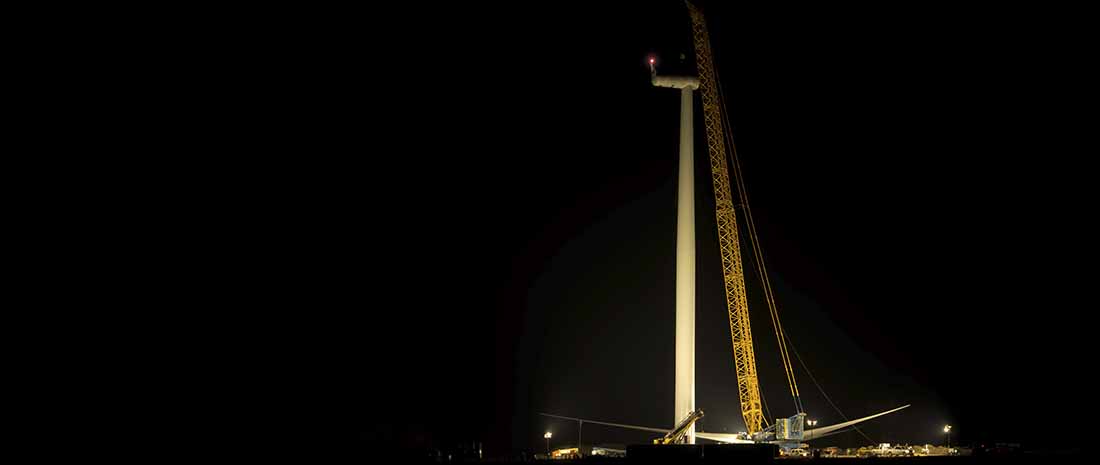Demystifying Obstruction Lighting During Wind Turbine Construction
Paul Longley, sales engineer, provides regulatory expertise on obstruction lighting for FAA wind turbines under construction for North American Windpower.
Demystifying Obstruction Lighting During Wind Turbine Construction
What you need to know about the new Federal Administration Guidelines
Statistically, wind turbines don’t cause many aviation accidents, but even one incident is more than enough to awaken builders to the absolute need to mark their turbines with obstruction lighting.
On a foggy day in April 2014, a private Piper airplane crashed into the blade of a wind turbine near Highmore, S.D., killing all four people on board. A National Transportation Safety Board investigation revealed the light on the turbine was not operational when the crash occurred. It was later revealed that the tower’s obstruction lighting had been inoperable for some time.
Since the 2007 Federal Aviation Administration (FAA) guidelines for obstruction lighting were published, there has been an increase in the number of wind turbine installations. As more and more wind turbines are built throughout North America, they present an increasing hazard to low-flying aircraft, particularly in poor visibility. According to the Wind Turbine FAQs on the FAA Obstruction Evaluation/Airport Airspace Analysis website – oeaaa.faa.gov – the FAA is receiving over 1,000 wind turbine filings each month to clarify American Wind Energy Association reports that the annual capacity installations have been 5,000 MW or more every year since 2007, while it was half or less in all of the years preceding.
Since the 2007 Federal Aviation Administration (FAA) guidelines for obstruction lighting were published, there has been an increase in the number of wind turbine installations. As more and more wind turbines are built throughout North America, they present an increasing hazard to low-flying aircraft, particularly in poor visibility. According to the Wind Turbine FAQs on the FAA Obstruction Evaluation/Airport Airspace Analysis website – oeaaa.faa.gov – the FAA is receiving over 1,000 wind turbine filings each month to clarify American Wind Energy Association reports that the annual capacity installations have been 5,000 MW or more every year since 2007, while it was half or less in all of the years preceding.
Lighting guidelines
Like other obstructions, such as radio antennas and electrical transmission towers, the FAA publishes guidance for wind turbine obstruction marking and lighting in its Advisory Circular (AC) 70/7460. The latest version, AC 70/7460-1L, was published Dec. 4, 2015, and has adopted some important new recommendations for wind turbines during their construction phase. In the previous 2007 version, AC 70/7460-1K, wind turbines under construction were to be lit using the same methods that apply to a permanent installation.
Like other obstructions, such as radio antennas and electrical transmission towers, the FAA publishes guidance for wind turbine obstruction marking and lighting in its Advisory Circular (AC) 70/7460. The latest version, AC 70/7460-1L, was published Dec. 4, 2015, and has adopted some important new recommendations for wind turbines during their construction phase. In the previous 2007 version, AC 70/7460-1K, wind turbines under construction were to be lit using the same methods that apply to a permanent installation.
The important guidelines that now apply to wind turbines under construction are summarized in the following:
- Wind turbines under construction are now only required to be lit by 32.5 candela L-810 lighting rather than the full 2,000 candela of L-864 lighting. At less than a tenth of the power consumption, the L-810 fixtures are less expensive, smaller, lighter and easier to handle than L-864s, making their initial and subsequent installations much simpler as construction progresses upward;
- The construction phase lights should be “steady burning,” which means the light is required to have a constant light signal. L-810s are, by definition, steady burning lights, whereas L-864s for permanent installations use a flashing pattern and all lights are synced to flash at the same time;
- All turbines under construction should be lit once they reach 200 feet (61 meters). Once the wind turbine farm is complete, the brighter permanent lighting configuration allows for gaps, depending on the wind turbine farm configuration; and
- If power is not available, the FAA recommends the light be solar-powered and “self-contained.” This means the LED light fixture, control electronics, batteries and solar panels should be encased in an all-in-one system as opposed to individual components bolted together with fasteners, cables and mounting brackets that tend to be bulky and exposed to the risk of breakage and corrosion. Power source options for temporary obstruction lighting include battery packs, fuel-powered generators and solar.
Overall, the new FAA changes for lighting construction-phase wind turbines provide a simpler and more cost-effective way to install temporary obstruction lighting while enhancing pilot safety at night. Always contact your local FAA office for information and guidance on how to fully ensure the compliance and safety of your project.

